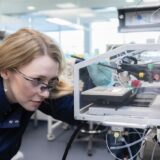What do you do when you’re not working at the Lighthouse Labs?
I’ve just completed my Master’s at the University of Sheffield.
How many years of scientific experience do you have?
I’ve spent the last 4 years studying biochemistry and genetics and am starting a PhD in October this year.
What is your role in the Lighthouse Lab?
My role in the Lighthouse Lab is to prepare the reagents needed and to carry out RNA extraction on the patient samples.
What is the key experience you bring to that role?
During my previous lab projects I have had experience doing qPCR analysis, including RNA extraction from cell lines. My previous work in labs has been in academia, working in Molecular Biology and Medical School labs.
How is it different to your regular role?
Working in the Lighthouse Labs is a very different experience due to the high volumes of patient samples we process every day. It is much more fast paced and is logistically a much larger operation.
Why did you want to get involved?
I wanted to join the team testing samples for coronavirus as I felt I could offer my lab experience to help the national testing effort in the fight against coronavirus.
What does it mean to you to be involved?
Knowing that by being involved in the Lighthouse Labs testing team you are helping key workers get back to work is very rewarding.
What is it like working alongside a host of new colleagues from both industry and academia?
It is exciting being part of such a huge national project which brings together scientists from both industry and academia all around the country.
What is the best thing about working in the Lighthouse Lab?
The best thing about working in these labs is how everyone comes together to work as efficiently as possible with the common goal of testing samples for coronavirus.
“The best thing about working in these labs is how everyone comes together to work as efficiently as possible with the common goal of testing samples for coronavirus.”



















































































































